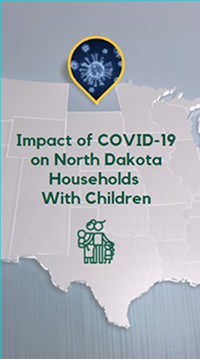Ask A Researcher
May 2022
Households with children have been disproportionately affected by the COVID-19 pandemic, especially in the first year of the pandemic.

Ina Cernusca is the project director for North Dakota Compass and a research specialist within the Center for Social Research. With extensive experience in market and social research, she has participated in many projects that involved quantitative and qualitative research, grant writing, project management, and outreach/extension activities. Born and raised in Romania, Ina moved to the United States in 2001 with her family. Ina earned her MBA from the University of Missouri, in Columbia, MO, and worked as a marketing research specialist with the Center for Agroforestry at the University of Missouri prior to moving to North Dakota.
In this article, Ina highlights results of the updated study on the impact of the pandemic on North Dakota households with children.
To continue to support North Dakota communities’ and organizations’ access to reliable and vetted data in context, the North Dakota Compass team analyzed recent Household Pulse Survey microdata and updated the Impact of COVID-19 on North Dakota Households with Children dashboard.
The dashboard reports selected impacts related to household economics, food insufficiency, mental health, health care, education and childcare, based on data collected in the following phases:
- First year of the pandemic: Phase 1 (April 2020-July 2020), Phase 2 (August 2020-October 2020), Phase 3 (October 2020-March 2021).
- Second year of the pandemic: Phase 3.1 (April 2021-July 2021), Phase 3.2 (July 2021-October 2021), Phase 3.3 (December 2021-February 2022).
Findings suggest that households with children have been disproportionately affected by the COVID-19 pandemic, especially in the first year of the pandemic:
- During the first year of the pandemic (Phases 1-3), households with children were more likely to have experienced a loss of employment income than households without children. In the second year of the pandemic (Phases 3.1-3.3), the survey asked about loss of employment income in the last four weeks. There is a chance that households with children were more likely to experience loss of employment income than households without children, but the margins of error overlap.
- Adults in households with children were more likely to experience difficulty with paying household expenses and staying current on rent or mortgage payments than adults in households without children.
- Food insufficiency of various degrees was more prevalent in households with children than households without children. Affordability was the most frequently reported reason for not having enough to eat, by both households with children and households without children. Early in the pandemic (Phase 1), the limited availability of desired food in stores was also a main reason reported for not having enough to eat.
- On average, about one in three adults in households with children (29%) reported that children in their households were not eating enough because the family could not afford enough food (people who responded true and often true).
- Throughout the pandemic, adults in households with children were two to three times more likely to have received free groceries or free meals than households without children. Households with children were more likely to receive free groceries or free meals in the first year of the pandemic than in the second year. In the first year of the pandemic, households with children most frequently relied on school programs with free meals to help mitigate food insufficiency.
- Adults in households with children more frequently reported experiencing mental health issues like worry and anxiety than households without children, especially in the early stages of the pandemic.
- Adults in households with children were more likely to delay medical care and not get needed medical care due to the COVID-19 pandemic than households without children. Both adults in households with and without children were more likely to delay getting medical care or not get it at the beginning of the pandemic than later during the pandemic.
- Adults in households with children reported that during the pandemic students spent less time on learning relative to time spent on learning before the pandemic.
- The impact of the pandemic on childcare arrangements was greatest in Phase 3.2 (July to October 2021) when about 80 percent of households with children were impacted (this question was asked only in the second year of the pandemic, Phases 3.1-3.3). Adults in households with children used various methods to deal with issues regarding childcare (e.g., used vacation or other paid leave to care for children, cut work hours in order to take care of children, and supervised one or more children while working).
Explore the dashboard to find more information on the impact of the pandemic on households with children.
The Household Pulse Survey, a unique and novel survey, measures the impact of COVID-19 on employment status, food security, housing, education, and physical and mental wellness. This survey was designed to be as comprehensive as possible, administered quickly, and provide data in near real-time. While the data have some limitations due to online administration and lower response rates, benefits are notable since the survey produces near real-time data to help measure the impact of the COVID-19 pandemic on households. Data collection for the Household Pulse Survey began on April 23, 2020 and is conducted in phases. Survey data are released through an interactive data tool, tables, and microdata. . The Household Pulse Survey Interactive Tool provides a visual representation of all the measures for the U.S., each of the 50 states and D.C., and for the 15 largest metropolitan statistical areas. Data tables in Excel for each week of release are available for download. In addition, microdata files are available to create custom tabulations and allow users to delve further into the rich data collected in the Household Pulse Survey.

